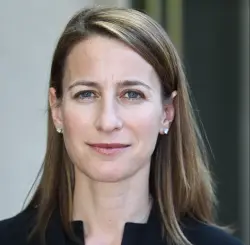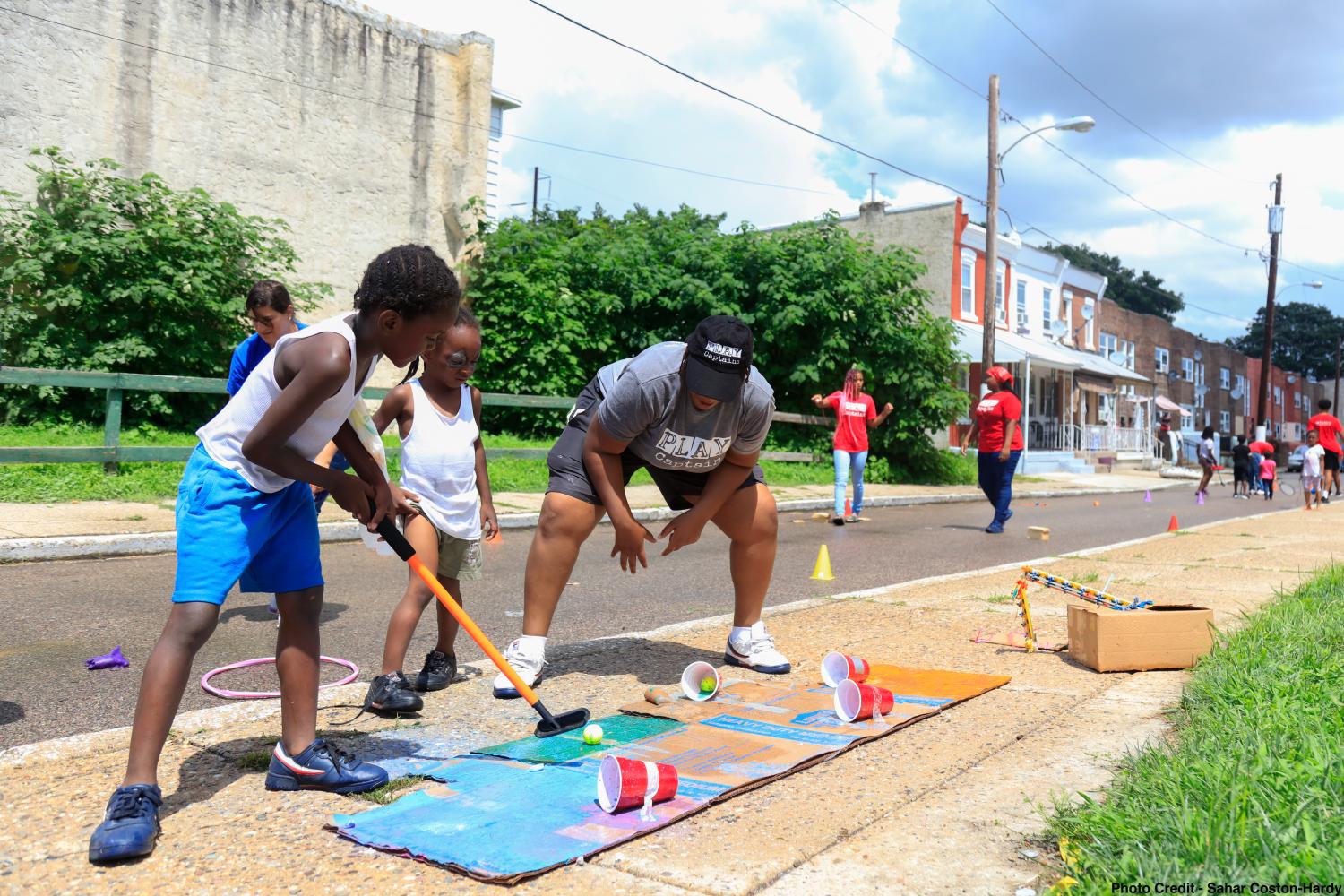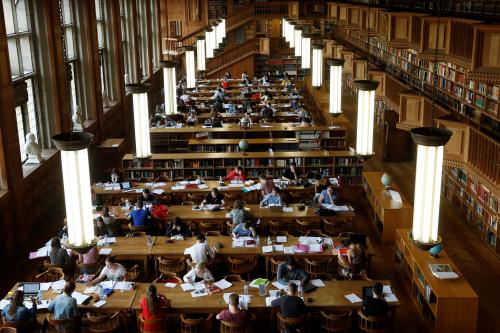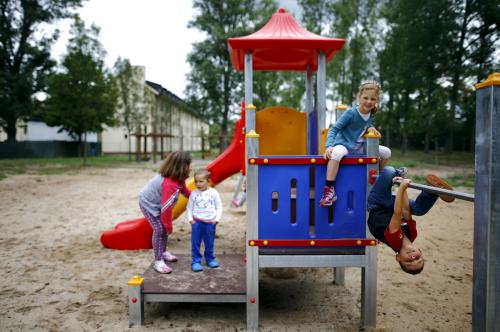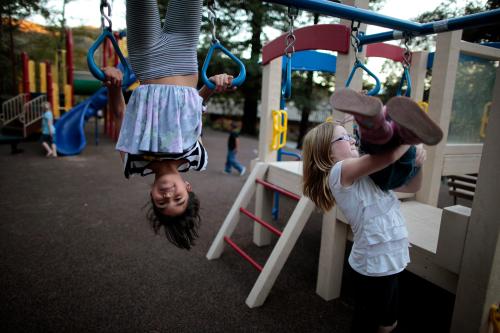Playful Learning Landscapes seeks to transform everyday spaces into playful learning opportunities to maximize “the other 80 percent” of time that children spend outside school. It lies at the intersection of the growing Child Friendly City movement and a global development agenda that calls for access to high-quality early childhood education for all. A joint project of Temple University’s Infant and Child Laboratory and the Brookings Institution, Playful Learning Landscapes is a broad umbrella initiative that marries community involvement and learning sciences with placemaking in order to design carefully curated playful experiences in everyday spaces. As it focuses on learning outcomes, particularly for children and families from under-resourced communities, Playful Learning Landscapes offers a new way to involve families in the kinds of experiences that enrich relationships and enhance children’s development.
If trends continue, almost 70 percent of the world’s nearly 10 billion people will live in cities by 2050. However, many cities lack play and learning outside the formal classroom. Although cities are experiencing growth and even revitalization, deprivation and social inequality persist. To address such gaps, policymakers have focused mainly on formal schooling. However, because children spend only an estimated 20 percent of waking hours in school, integrating playful learning into everyday spaces provides a powerful opportunity to augment school-based efforts, to increase learning outcomes, and to reduce inequities.
In Philadelphia, there is an opportunity to draw important insights and learning for Playful Learning Landscapes from a network of organizations that collaborate to create playful learning installations across the city, to establish proof of concept for those interventions, and to inform the broader Playful Learning Landscape initiative. Philadelphia aims to serve as an international model for how playful learning can be embedded into a city’s everyday spaces so it enhances children’s development and supports community-wide change for families.
This report documents the scaling journey to date of Philadelphia Playful Learning Landscapes (PPLL) and the lessons learned, to help inform further expansion in Philadelphia and with adaptation and adoption by other cities and countries. Lessons are targeted toward city-level actors—policymakers, implementers, researchers, and funders in Philadelphia and beyond—who wish to expand and sustain evidence-based approaches that foster learning and caregiver–child interactions in public spaces and everyday spaces where people regularly go and can be easily engaged. The aim is to move beyond supporting the replication of a single installation, to shaping the mainstream practices of business, government, and other organizations to incorporate playful learning principles and design into their own work.
Three groups of key insights emerged from Philadelphia, including efforts to apply learning from PPLL to other cities and reinforced by relevant lessons from scaling other social innovations.
Scaling Building Blocks
The first group of findings are organized around essential components—or building blocks—required for scaling and sustaining playful learning installations and activities across locations. Those findings include recognizing the importance of the following:
• Cultivating visionary leaders and public champions to inspire and accelerate the expansion of playful learning efforts while considering early on how leadership needs will evolve in transition to larger scale;
• Forging key alliances and partnerships with institutions that have the capacity for large-scale delivery, as well as with organizations that have deep roots in communities, thereby constructing a tent big enough to encompass the wide range of entities that are working on play and learning;
• Ensuring that community engagement remains core to the design, delivery, and monitoring of any playful learning installation or activity, along with having clear processes in place for ensuring their meaningful participation; and
• Using relevant data to motivate action, inform the design and implementation of any response, and sustain actions, all of which require clarity about how success is defined, how it will be measured, and—most important—how data will be shared and used.
Scaling Strategies
The second group of findings relates to different strategies and approaches to scale that appeared to be important when scaling playful learning efforts throughout Philadelphia and other cities. As with other scaling-related approaches, these are not mutually exclusive but are often pursued simultaneously:
• Pursuing flexible adaptation as the initiative continues to spread across Philadelphia and to other locations, thereby underscoring the importance of cities and neighborhoods to tailor playful learning installations and activities to their own context without losing a core set of scientific principles that lead to impact;
• Strengthening the overall playful learning field, which includes (a) growing the field by raising awareness and cultivating more partners to join and (b) building the capacity of existing players that are already committed to playful learning; and
• Integrating playful learning principles into existing goods and services that families and communities already use, with the aim of infusing playful learning principles so that using them while designing any public or everyday spaces will eventually become second nature.
Scaling Mindsets
The final set of findings relates to certain scaling mindsets that contributed to—and will continue to be important for—the ongoing expansion and adaptation of playful learning efforts. PPLL’s journey to date has underscored a need for the following:
• Encouraging flexibility and agility as scaling any playful learning initiative is far from a linear process and requires ongoing data-driven refection, experimentation, and adaptations to existing strategies and plans;
• Maintaining a focus on place-keeping as part of any placemaking effort, given challenges across the board for maintenance of play-related installations in public spaces; and
• Considering unintended consequences early on as playful learning initiatives scale, some which might not appear to be issues during a pilot stage but could become obstacles once activities have reached a larger population.
Call to Action
These lessons inform a set of recommendations for policymakers, implementers, funders, and researchers to further expand and sustain playful learning opportunities in communities and cities around the world. More specifically, the following call to action is for actors that are fostering a playful learning movement. Those actors include but are not limited to ones involved with PPLL and with the broader Playful Learning Landscapes initiative:
1. Generate robust evidence about playful learning to continue to build the evidence base and gather data that will enable continuous learning. Given the critical role that data play in the scaling process, there is a need to better understand the impact of playful learning and how it is sustained over time. This includes developing a few shared metrics across playful learning initiatives that will measure both shorter- and longer-term improvements on child development outcomes, as well as community revitalization impacts. For funding partners, it is critical to focus on the entire innovation–learning–scaling cycle as a coherent package to advance and sustain playful learning efforts city-wide.
2. Capture and codify key elements and approaches to implement playful learning initiatives. Transforming cities and towns into vibrant learning communities requires not only more information and evidence about what is working but also more guidance and support around how it is achieved. To cultivate and engage thought leaders and champions, lessons learned and evidence gathered must be codified and broadly shared in actionable ways. In addition to sharing more knowledge, the organizations and community groups involved with expanding playful learning opportunities also require support in designing, implementing, and monitoring playful learning activities. Such support can be in the form of design templates, guidelines, tools, and technical assistance. This type of targeted guidance in support of flexible adaptation can help other cities to create their version of Playful Learning Landscapes while still adhering to fundamental principles and maintaining quality as the movement spreads.
3. Build a coordinated global movement around playful learning. The task of improving children’s learning outcomes, urban renewal, and other complex social challenges requires the combined efforts of all. Given the importance of partnerships for sustaining impact, a strong, coordinated network of actors is needed to collectively pool expertise, resources, and skills around a shared vision and aligned incentives. A central hub is critical to strengthen the playful learning field, while helping to coordinate efforts, to connect partners, and to share the learning that emerges across various sites. The Sustainable Development Goals provide a common north star to focus attention across locations, electoral cycles, and levels of government, given its call for universal access to quality education and early childhood development and care.
Photo credit: Sahar Coston-Hardy
